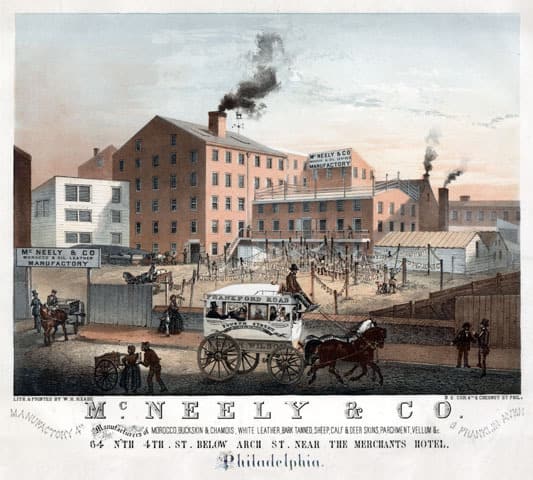New Grant Funds Library Company’s Exploration of Philadelphia’s Colorful Past

Printed by W.H. Rease, ca. 1860. The caption reads, “McNeely & Co. manufacturers of morocco, buckskin & chamois, white leather, bark tanned, sheep, calf & deer skins, parchment, vellum &c. 64 N. 4th. St. below Arch St. near the Merchants Hotel, Philadelphia.” The McNeely family operated a leather manufactory in Philadelphia from 1830 until the early 20th century.
Long before circulars jammed our mailboxes and glossy advertisements for every department store in the city came sliding out of the Sunday paper, lithography was the word—and the image—on the street. Invented in the late 1700s, lithography transformed the iconography of Philadelphia (and our entire nation) as a new process that used large slabs of limestone as the printing surface. It made possible the cost-effective use of color and allowed designers to easily combine text and images. Our contemporary visual culture has its roots in early tickets, letterhead, forms, circulars, and—most importantly—advertisements.
The Library Company of Philadelphia has received a three-year grant from the William Penn Foundation toward Philadelphia on Stone: the First Fifty Years of Lithography, which will explore the work of Philadelphia’s 19th-century lithographic artists and printers. Despite increased scholarship in recent years, this is the one of a few studies of commercial lithography as practiced in one city. The project includes plans for a digital catalogue of more than 800 lithographic views of Philadelphia, an illustrated biographical dictionary of early commercial lithographers, a collection of essays, and a public exhibition.
The images tend to have broad appeal because they provide richly detailed depictions of Philadelphia street scenes, commercial life, and architecture,” says Jennifer Ambrose, Associate Curator of Prints & Photographs at the Library Company and director of the project. “We think anyone interested in the city’s past, as well as professionals like scholars and graphic artists, will find these images relevant and compelling.” Those interested in the development of American consumer culture will also appreciate these images that are foundational to the modern advertising industry.
As Philadelphia made the radical transition from seaport to manufacturing center, store owners often commissioned lithographic views that showcased window displays of merchandise, new architectural features, and signage. Shoppers, pedestrians, street vendors, errand boys, and every type of vehicle are part of lively street scenes that are beautiful in their detail. In these images, lithographers preserved the colorful images of daily life in the 19th century—including depictions of women, African-Americans and working-class laborers who were often excluded from traditional portraiture.
The digital catalogue of lithographs will be a free, openly-accessible resource for print curators, collectors, genealogists, and historians. Several views are already available online in the Wainwright collection of ImPAC, an image database accessible through the Library Company’s website. While the Library Company holds the largest collection of Philadelphia scenes by local firms from the early decades of commercial lithography, the catalogue will also include images surveyed and scanned from the collections of institutions throughout the region. The final exhibition will coincide with Philagrafika 2010, an international art quadrennial focused on the role of the printed image in shaping contemporary visual culture around the globe.
The Library Company’s Print & Photographic Department specializes in 19th-century depictions of Philadelphia and works by regional artists. Free and open to the public, the Library Company of Philadelphia—founded by Benjamin Franklin in 1731—is an independent research library concentrating on American society and culture from the 17th through 19th centuries. The Library Company’s mission is to preserve, interpret, make available, and augment an extensive non-circulating collection of rare books, manuscripts, broadsides, ephemera, and works of art.


![Fig. 1. John H. Webster, Jr., [Stouton, Webster family residence, Kensington and Indiana Avenues, Philadelphia, Pa.], ca. 1890. Glass plate negative.](https://librarycompany.org/wp-content/uploads/cfav_03a-1-80x80.jpg)
Leave a Reply
Want to join the discussion?Feel free to contribute!